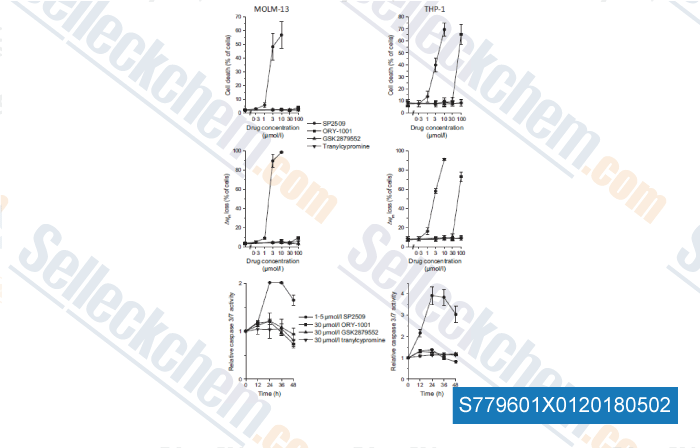|
Toll Free: (877) 796-6397 -- USA and Canada only -- |
Fax: +1-832-582-8590 Orders: +1-832-582-8158 |
Tech Support: +1-832-582-8158 Ext:3 Please provide your Order Number in the email. |
Technical Data
| Formula | C23H28N2O2.2HCl |
||||||
| Molecular Weight | 437.4 | CAS No. | 1902123-72-1 | ||||
| Solubility (25°C)* | In vitro | DMSO | 87 mg/mL (198.9 mM) | ||||
| Water | 42 mg/mL (96.02 mM) | ||||||
| Ethanol | Insoluble | ||||||
| In vivo (Add solvents to the product individually and in order) |
|
||||||
|
* <1 mg/ml means slightly soluble or insoluble. * Please note that Selleck tests the solubility of all compounds in-house, and the actual solubility may differ slightly from published values. This is normal and is due to slight batch-to-batch variations. * Room temperature shipping (Stability testing shows this product can be shipped without any cooling measures.) |
|||||||
Preparing Stock Solutions
Biological Activity
| Description | GSK2879552 2HCl is a potent, selective, orally bioavailable, irreversible LSD1 inhibitor with Kiapp of 1.7 μM. Phase 1. | ||
|---|---|---|---|
| Targets |
|
||
| In vitro | In 165 cell lines, GSK2879552 inhibits the growth of 9/28 small cell lung carcinoma (SCLC) lines and 20/29 AML lines ranged from 40% to 100%. The subset of SCLC lines and primary samples that undergo growth inhibition in response to GSK2879552 exhibit DNA hypomethylation of a signature set of probes. [1] | ||
| In vivo | In SCLC xenograft bearing mice, GSK2879552 (1.5 mg/kg, p.o.) demonstrates tumor growth inhibition by 17%-83%. [1] |
Protocol (from reference)
| Kinase Assay:[1] |
|
|---|---|
| Cell Assay:[1] |
|
Customer Product Validation

-
Data from [Data independently produced by , , Br J Haematol, 2017, doi: 10.1111/bjh.14983]
Selleck's GSK2879552 2HCl has been cited by 22 publications
| Pharmacological inhibition of LSD1 suppresses growth of hepatocellular carcinoma by inducing GADD45B [ MedComm (2020), 2023, 4(3):e269] | PubMed: 37250145 |
| E3 ligase Trim35 inhibits LSD1 demethylase activity through K63-linked ubiquitination and enhances anti-tumor immunity in NSCLC [ Cell Rep, 2023, 10.1016/j.celrep.2023.113477] | PubMed: 37979167 |
| Crucial Role of Lysine-Specific Histone Demethylase 1 in RANKL-Mediated Osteoclast Differentiation [ Int J Mol Sci, 2023, 24(4)3605] | PubMed: 36835016 |
| Crucial Role of Lysine-Specific Histone Demethylase 1 in RANKL-Mediated Osteoclast Differentiation [ Int. J. Mol. Sci, 2023, 24(4)] | PubMed: None |
| Integrative analysis of drug response and clinical outcome in acute myeloid leukemia [ Cancer Cell, 2022, S1535-6108(22)00312-9] | PubMed: 35868306 |
| Systematic identification of biomarker-driven drug combinations to overcome resistance [ Nat Chem Biol, 2022, 10.1038/s41589-022-00996-7] | PubMed: 35332332 |
| TRACE generates fluorescent human reporter cell lines to characterize epigenetic pathways [ Mol Cell, 2021, S1097-2765(21)01037-6] | PubMed: 34963054 |
| KRT6A Promotes Lung Cancer Cell Growth and Invasion Through MYC-Regulated Pentose Phosphate Pathway [ Front Cell Dev Biol, 2021, 9:694071] | PubMed: 34235156 |
| Inhibition of epigenetic modifiers LSD1 and HDAC1 blocks rod photoreceptor death in mouse models of Retinitis Pigmentosa [ J Neurosci, 2021, JN-RM-3102-20] | PubMed: 34193554 |
| HeLa TI cell-based assay as a new approach to screen for chemicals able to reactivate the expression of epigenetically silenced genes [ PLoS One, 2021, 16(6):e0252504] | PubMed: 34115770 |
RETURN POLICY
Selleck Chemical’s Unconditional Return Policy ensures a smooth online shopping experience for our customers. If you are in any way unsatisfied with your purchase, you may return any item(s) within 7 days of receiving it. In the event of product quality issues, either protocol related or product related problems, you may return any item(s) within 365 days from the original purchase date. Please follow the instructions below when returning products.
SHIPPING AND STORAGE
Selleck products are transported at room temperature. If you receive the product at room temperature, please rest assured, the Selleck Quality Inspection Department has conducted experiments to verify that the normal temperature placement of one month will not affect the biological activity of powder products. After collecting, please store the product according to the requirements described in the datasheet. Most Selleck products are stable under the recommended conditions.
NOT FOR HUMAN, VETERINARY DIAGNOSTIC OR THERAPEUTIC USE.
